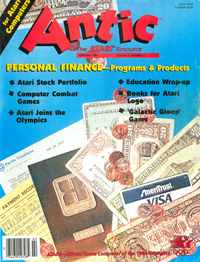|
Vaughan Family Timestream® Maps |
| Home Biography People Places Multimedia: Making It Work On the Water Writings/Presentations |
Complete Personal Accountant
Reviewed by Tay Vaughan
In Antic Magazine, February, 1984 (Page 96)
Product from: Futurehouse, Inc.
310 W. Franklin St.
Chapel Hill, NC 27514
(919) 967-0861
$79.95, 48K - diskette
The Complete Personal Accountant consists of ten programs for managing financial records, appointment schedules, and mailing lists. These ten programs are supplied on three disks; additional disks are required for the storage of data. A sizable booklet of instructions and examples provides detailed guidance for use and application of the CPA programs at home and in a small business.
Programs available are: chart of accounts, checkbook maintenance, checkbook search, summary budget analysis, detail budget analysis, net worth/income expense, payments calendar, appointments calendar, mailing list, and color graph.
Anyone who has started a small business or has had bookkeeping experience will recognize in these programs the essential ingredients of a common accounting system.
The Chart of Accounts is a list of the various categories in which money is spent or earned (categories include "salary;' "rent;' "medical bills;' and even "penalties and fines"). A standard chart provided by CPA is divided into asset, liability, equity, income, and expense accounts. This chart can be easily customized by the user. Because all of CPA's financial processing programs refer to this list, the Chart of Accounts must be created and stored the first time the CPA program is used. Values are then posted to their proper category in the Chart of Accounts; 99 accounts can be listed, and each can include up to nine subaccounts.
Most people have had simple bookkeeping experience with their own checking accounts. CPA provides a computerized checkbook register and maintenance program to help balance a checkbook and keep permanent records of tax deductions, service charges, and deposits. Checks are automatically credited or debited to their appropriate accounts, and running totals are kept for all categories. A search option allows users to recall checks by number, date, amount, or payee, and to print or display them.
Budgets are also important for successful money management. CPA uses the Chart of Accounts to maintain a list of budgeted categories for the user, and also provides a general summary of budget status (with totals of budgeted amounts and amounts actually spent). A detailed analysis displays or prints budget items, and lists actual checks and cash expenditures by category. If users faithfully update their data files, they can compute their net worth and generate a balance sheet at any time. Savings, stocks, bonds, investments, and other financial data that do not appear in checking accounts, are entered through a Net Worth/Income Expense program.
Two calendar programs allow users to keep track of dates when monthly bills are due, and to schedule appointments . The Mailing List program provided by CPA is useful for such things as Christmas lists or client directories, but is not as flexible as some other databasemanagement programs. It is limited to names and addresses, although a 20-character field is provided for telephone numbers or other reference data. The Mail List prints only one name wide, so it can use friction-fed rolls of labels on the Atari 825, Centronics 737, or Epson MX-80 printers.
With the Color Graph program, users can produce a graph of any file that contains CPA financial data. Relationships between various accounts can also be shown graphically.
CPA is designed for a single-drive system, it has no option for multiple drive users. A great deal of disk swapping is therefore required. Error trapping is generally good, but not all decision branches in the menu-driven system allow for a return to the menu if the user changes his or her mind. Also, it is sometimes difficult to get an overview of a financial situation (such as the checkbook register) without using the printer. Displays of checks and names appear only one at a time on the display screen. For a $20 fee, users can subscribe to a technical-support service from the publishers by telephone.
These are well-integrated programs that provide the backbone of a financial management system. Indeed, simply by following the step-by-step procedures outlined in the manual and faithfully entering the necessary data, many users will discover that their financial records are more organized and make more sense than ever before.

